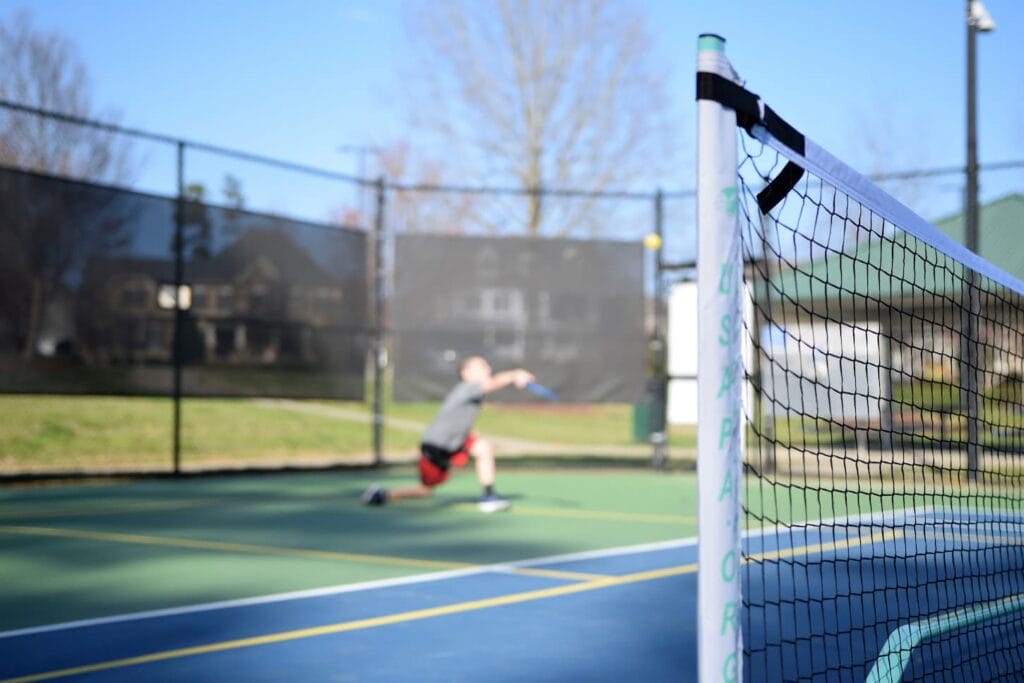If you’ve recently driven by the local tennis courts, there have more than likely been groups of pickleball players challenging their skills on the court. As a tennis player or just in general, your first thought may have been can they do that? Will that damage the tennis courts?
Though it is unlikely that playing a game of pickleball on a tennis court will damage the court itself, the adjustments needed to make a tennis court viable as a pickleball court can cause harm, confusion, or at the very least frustration, when not done carefully.
We will go over exactly why pickleball on tennis courts is controversial, if it’s okay to play pickleball on tennis courts, and whether or not this will ultimately damage tennis courts.

Why Playing Pickleball on Tennis Courts is Controversial
Because pickleball players need to make changes to the tennis court and it interferes with the time and space available for tennis players, playing pickleball on tennis courts is controversial.
Lines that are drawn on the court for pickleball can sometimes confuse the tennis players while they are playing their game.
With the growing popularity of pickleball skyrocketing, tennis players may be standoffish to the idea of their courts being taken over and modified by this new pickleball hobby.
Totally understandable! After all, there aren’t loads of publicly available tennis courts anyway, and now more people want to use them – but for pickleball?
Many similarities are shared between the game of tennis and pickleball, including the use of rackets or paddles, a single ball, a single net, and the possibility of playing as a single or in teams of two.
When reviewed closely, you will begin to see that though similar, the two sports have many differences. The size of the court, equipment, scoring and general rules differ greatly between the two sports.
Playing Pickleball on Tennis Courts: Here’s What Happens
The changes made in the tennis court by pickleball can cause lasting damage. Even if no physical damage is done, if newly defined pickleball lines are not erased or nets are not returned to their previous state, confusion and frustration may ensue.
Pickleball is quickly becoming one of the most popular sports in America. If unfamiliar with pickleball, you’re likely to hear about it soon as it is quickly becoming one of the most popular sports there is. Between 2019 and 2020, the Sports & Fitness Industry Association reports there was a 21.3% increase in pickleball participation (source).
This newfound enthusiasm around pickleball doesn’t seem to be diminishing any time soon. But what happens when pickleball players convert traditional tennis courts to pickleball courts? Though there are many similarities between tennis and pickleball, there are just as many differences.
Though both are traditionally played on hard courts, clay, or grass, the dimensions of a pickleball court are different from that of a tennis court. Net heights also differ between the two sports.
In tennis, general net heights are 42 inches high at the end and 36 inches in the middle. For pickleball, the net height at the ends should be 36 inches, and 32 inches in the middle of the net.
Though these are simple differences, these net and court dimensions can cause confusion for players if modifications are made haphazardly.
In order to modify a tennis court for pickleball, new lines must be drawn or created, new net heights are to be adjusted for, and in most cases, two pickleball courts can fit into one tennis court, doubling the number of courts available for pickleball fanatics.
Though this may be good news for pickleball players, it may cause frustration among the local tennis chapters. Availability is always a concern for recreational sports. Even more concerning to tennis fans is the potential for their courts to be damaged by these modifications.
What’s The Best Surface to Play Pickleball On?
The best (and preferred) surface to play pickleball on is a level, cushioned, and shock-absorbing surface. The surface should be coated with flexible acrylic blinders for good cushioning and grip to help protect the players’ knees.
One of the great aspects of pickleball is that it can be played on many surfaces. Though a smooth, hard, acrylic-based surface is best for playing, pickleball can also be played on concrete, grass, or clay.
With so many options, why do we so often see pickleball players on tennis courts instead of basketball courts or other athletic arenas? The reasoning may be simple.
Tennis and pickleball share many traits. Just like pickleball, tennis is also played on hard, reinforced surfaces. It can also be played on grass or clay.
Because of these similarities, many tennis players play pickleball, and many pickleball players play tennis. Though a subtle rivalry between the sports may exist, there may be more camaraderie between the sports than previously thought.
The use of tennis courts is an easy, accessible, and usually affordable option for pickleball. Though some modifications must take place, the general principles, outline, and rules of the game make it easy to convert tennis courts to pickleball courts.
Can You Play Pickleball on a Tennis Court?
There is no reason to believe that playing pickleball on a tennis court causes damage to the surface, net, or pre-determined lines of a traditional tennis court. In fact, given the dimensions of tennis and pickleball courts, they make a great option for pickleball players.
But wait – it’s not all that simple. If you’re looking to convert a tennis court to a pickleball court, there are some rules to follow.
Wait your turn
Though pickleball may not damage tennis courts, it does cause a steep decline in court vacancy. The rivalry between pickleball and tennis likely has more to do with infighting over public or private courts than it does with damage being done to the court.
Setting up shop on someone else’s turf (or concrete in this matter) should only be done after you’ve waited your turn. Because it takes extra time and personalization to change a tennis court to a pickleball court, approval and access should be granted before any takeover occurs.
After all, the tennis court was there first and was designed for tennis!
Don’t overstay your welcome
A typical three-set public tennis match usually takes about 90 minutes. This means that those waiting for a court can assume one will become available within a two-hour scheduling window.
With the extended time setup and clean-up requires for modifying a tennis court for pickleball, a typical pickleball match may last much longer. Do your best to be aware of the wait times and do not overstay your welcome. Once you have a court, use it. Just don’t hog the thing!
Clean up after yourself
When a tennis match is over, it’s super easy to pick up the racket and balls and close the gate behind you. If only it were that simple for pickleball players.
Since you need to measure out the space, place new lines down, and adjust net heights, it is essential that pickleball players be good guests and adjust the tennis court back to its original state before heading off.
A tennis court was made for tennis and should be set up for a tennis match at all times unless being presently used for pickleball.
If you don’t like the sound of sharing, lobby your local municipality or tennis pavilion for more pickleball courts! At least with pickleball-specific courts, they can’t be modified for tennis, so you’re in the clear from having to share!
Key Takeaways and Next Steps
Does pickleball damage tennis courts? Well, no – the issue here seems to be that it causes a decline in court vacancy. There is a rivalry between tennis and pickleball players over having to share space in public or private courts, not over any damage being done to tennis courts.
Pickleball can be played on tennis courts along with several other types of surfaces, such as concrete, grass, or clay. The use of tennis courts is an easy, accessible, and affordable option for pickleball. If you are interested in reading more about pickleball and other similar racket-based games, read these great articles:
- Let’s Compare: Badminton, Tennis, Table Tennis, and Pickleball
- Is It Better To Have A Lighter Or Heavier Pickleball Paddle?
- Do You Have to Serve Diagonally in Singles Table Tennis?
Resources
Learning from your own experiences is important, but learning from others is also smart. These are the sources used in this article and our research to be more informed as a family of sports nuts wannabes.
- Boone, Stan. “What Are the Different Pickleball Playing Surfaces?” Racket Sports World, 16 Apr. 2021, racketsportsworld.com/pickleball-playing-surface/.
- Hadlich, Gui. “How Long Do Tennis Matches Last?” My Tennis HQ, 15 Mar. 2021, mytennishq.com/how-long-do-tennis-matches-last/.
- Patton, Emily. “Pickleball Court Dimensions.” Onix Pickleball, 3 Mar. 2021, www.onixpickleball.com/blogs/learn-pickleball/pickleball-court-dimensions.
- “Pickleball Participation Report 2021.” Copyright 2022 by SFIA, www.sfia.org/reports/949_Pickleball-Participation-Report-2021. Accessed 7 Mar. 2022.
